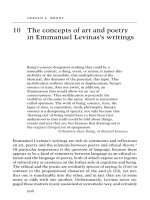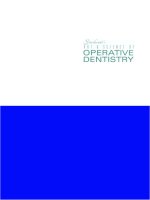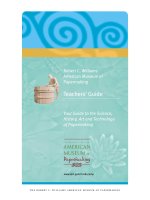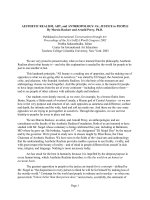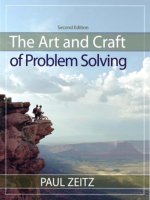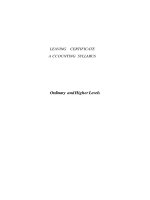SYLLABUS Art and Humanity
Bạn đang xem bản rút gọn của tài liệu. Xem và tải ngay bản đầy đủ của tài liệu tại đây (164.49 KB, 20 trang )
09/QT-ĐTĐH/BM08
SYLLABUS
Art and Humanity
(BSA1057-E)
(Issued with Decision No. ………./ QĐ-ĐHKT dated on……………)
1. Instructor information
1.1 Instructor 1:
Full name: Richard Mark Nixon
Title, academic title and degree: Associate Professor, Ph.D., Second Language
Education
Office: R.307, E4 Building, University of Economics and Business, VNU
Cell phone: 01235808365
Email:
Main researching orientation: Humanity
1.2 Instructor 2:
Full name: Vu Kim Thu
Title, academic title and degree: M.F.A., Visual Arts
Office: R.307, E4 Building, University of Economics and Business, VNU
Cell phone: 01234154828
Main researching orientation: Visual Arts
2. Course description
Course name: Art and Humanity
Course code: BSA 1057-E
Number of credits: 3
Prerequisite: Teamwork Skills, presentation, writing.
Credit hours: 45
• Lecture: 16
• In-class discussion and assignment: 29
Venue:
Faculty in charge of the course: Business Administration.
1
3. Course objectives:
This course aims to equip general knowledge in Art and Humanity to students as well
as to develop personal, professional and interpersonal skills and attributes for students.
3.1. Knowledge
Students are expected to be able to:
• Understand the main concepts of Art: Visual art, Literature, Music, Film and
Performance Art, from both Western to Eastern regions
• Understand these concepts in relationship to humanity issues such as Religion,
Politics, Social Studies and Cultural Contexts
3.2. Personal and professional skills and attributes
Through the course, students’ personal skills are developed to the point where they are
able to:
• Be open minded about Art and Culture
• To recognize Art from according to culture origin and geographic region
• Presentation skill
• Work collaboratively in teams and hold simulative discussions
3.3. Interpersonal skills and attributes
In using the teaching and learning methods such as in-class discussions, case study
preparation and group presentation, homework, essays and tests, students are required
to develop and enhance their interpersonal skills
• To use power point presentation
• To be able to document or capture images of interests, such as photography,
draft sketches, and taking notes
• Being able to effectively use photo shop ( if needed)
3.4. Ability to apply knowledge into practice
By course’s end the students will be able to: 1) recognize the Art work and categories
of Art from different cultures; 2) develop critical thinking; and 3), analyze Art and
Humanity concepts.
2
4. Course overview
This course is an introduction to and survey of Art and Humanity with the purpose of
helping students to understand and appreciate art and what it has to offer. The class
will include a combination of lectures, discussions, workshops, and field trips.
Through the fifteen classes we will consider materials and techniques, historical,
religious, and cultural contexts, as well as ideas, concepts, and aesthetics. In addition,
students will study developments in a studio exercises, explore the formal elements of
visual language and how it functions in communicating ideas and emotions.
A study of humanity will help the students to realize that art lies in the heart of human
experience. The course will help students develop an approach to variety of artistic
expressions – painting, sculpture, photography, film, music, theater and dance. Within
these art forms, we will discuss subjects related to humanity studies such as religion,
spirituality, ethics, politics and cultural value.
5. Course details
PART 1: Introduction
1. Definition of Art
2. Themes and Purposes of Art
2.1.
Religious practice
2.2.
Documenting daily life
2.3.
Aesthetic beauty
PART 2: The vocabulary of Art
1. The language and vocabulary of Art
2. The Visual Elements: Colors, composition, shape, line, perspective
PART 3: Two-dimensional media
1. Concept of two-dimension media
2. Religion and Art How religion shapes society
3. Drawing
3.1.
A variety of artwork from Japanese wood-cut to Van Gogh’s drawing
and from calligraphy to children drawing.
3.2.
How to develop the artwork from doodles (drafts)
4. Painting from the 14th century until present day
3
5. The technique of etching, lithography, wood-cut and silk screen.
6. Journalist photography, studio photography, landscape, portrait and
advertisement
PART 4: Three-dimensional media
1. Sculpture: The concept of three dimension and relationship with space
2. How society perceive human body images
PART 5: Arts in time
1. Comparative styles in world art: movements, style and characteristics in
each culture
2. Modernism: The century of styles.
3. Pop culture – the impact on today’s society
PART 6: ART AND HUMANITIES
1.
2.
3.
4.
5.
Human Rights, Art as a social force, Art as a weapon
YAWP (Youth at War & Peace)
New media and technology
Surrealism and imagination
Humanity in performing Art
6. Textbooks and references
6.1 Required books
Main sources
1a. Gardner, H., Tansey, R., Kleiner, F.S., & Kleiner, F. (1995). Gardner's Art Through
The Ages: I: Ancient, Medieval, and Non-European Art. 10th Edition. Harcourt
Publishing.
1b. Fred S. Kleiner (2010). Gardner’s Art through the Ages: The Western Perspective,
Thirteenth Edition, Vol. II. Clark Baxter Publisher.
2. Getlein, M. (2009). Living with Art Seventh Edition. McGraw-Hill Humanities.
Second sources
3. Đinh Hồng Hải (2012). Những biểu tượng đặc trưng trong văn hóa truyền thống
Việt Nam (Characteristic Symbols in Vietnamese Traditional Culture)
Vol.1. Tri thuc Publishing House.
4. Alfred Gell (1998). Art and Agency. Oxford University Press.
4
5. Phan Cẩm Thượng (2011). Văn minh vật chất của người Việt. First Edition. Nhà
xuất bản Tri Thức.
6.2 References
1. Elsen, A. (1997). The Purposes of Art. Harcourt College Publishers
2. Sporre, D. J. (2011) Perceiving the Arts: An Introduction to the Humanities. Tenth
Edition. Pearson.
7. Teaching methods:
•
•
•
•
•
•
•
Lecture
Discussion/Debate/Small exercises
Group activities
Student Presentations
Practices through games and projects
Studio projects
Field trips
7.1 Course Calendar
Week
1
2
3
4
5
6
7
8
9
Teaching Method
(Credit hours)
Total
Discussion/
Lecture
Exercises
Lecture Topics
Definition of Art
The purpose of Art
Religion and Art How religion shapes
society
Field Trip to the Museum of Fine Arts –
66 Nguyen Thai Hoc
Figurative images How society
perceives human body images
Modernism: The century of styles.
Pop culture – the impact on today’s
society
Human Rights, Art as a social force, Art
as a weapon
Midterm exam
YAWP (Youth at War & Peace): A
collaboration program of Sacred Slam
New media and technology
5
2
1
3
2
1
3
1.5
1.5
3
1
2
3
1.5
1.5
3
1.5
1.5
3
1
2
3
3
3
1.5
3
1.5
Assessment
and Grading
35%
Week
10
11
12
13
15
Teaching Method
(Credit hours)
Total
Discussion/
Lecture
Exercises
Lecture Topics
Creating a story with your Art through
collage projects
Surrealism and imagination
Field trip to cultural art center outside of
Hanoi
Humanity in performing Art
Final presentations: Part 2
2
3
1
3
Approximately 5 hours.
1.5
16
hours
Total
3
Assessment
and Grading
1.5
3s
3
3
29 hours
45
hours
7.2 Detail studying calendar
Week 1: Definition of Art
Teaching methods
Lecture
Credit Hours: 2
Time,
Main Contents
Before class
Note
Venue
In-class Introduction to the course and
Reading:
content
Chapters 2, 3 and
Definition of Art The language and 4 of “Living with
vocabulary of Art (composition, form, Art” by Getlein,
color, line, shape, mass, contrast, hue,
M.
mark, perspectives) 2D, 3D, 4D
Discussion/Exercises
Credit Hours: 1
Assessment/Grading
Observing 14 to 20 images and
writing your interpretation about
what you see.
Class attendance, in-class
contribution and discussions, Q & A
• Week 2: Art and Religion
Teaching methods
Lecture
Credit Hours: 2
Time,
Venue
Inclass
Main Contents
Before class
Religion and Art How
Reading: Chapters
religion shapes society
15, 18 and 19 of
Images of God and
“Living with Art”
Goddesses from the East to
by Getlein, M.
the West: Buddhist Art,
Hinduism Art, Christian Art Reading: Buddhist
6
Note
Teaching methods
Time,
Venue
Discussion/Exercises
Credit Hours: 1
Assessment/Grading
Main Contents
Before class
and Islamic Art. The
concept of religion and how
it shapes society and culture
Group project: Divide class
into 6 groups, each group
will assume one particular
religion and do a
presentation about their
research
Class attendance, in-class
contribution and
discussions, Q & A
Art by Meher
McArthur
Note
• Week 3: Field trip to visit the Fine Arts Museum – 66 Nguyen Thai Hoc
Teaching methods
Lecture
Credit Hours: 1.5
Discussion/Exercises
Credit Hours: 1.5
Assessment/Grading
Time,
Main Contents
Venue
Out- Field Trip to The Museum of
class Fine Arts – 66 Nguyen Thai
Hoc, Hanoi (This trip will
focus on the studies of Visual
art and its reflection of
Vietnamese history and
culture.)
Discussion on favorite pieces.
Before class
Note
Research:
Vietnamese Art of
the Ly, Tran, Le
Dynasty and
19th/20th century
Class attendance, in-class
contribution and discussions,
Q&A
• Week 4: How society perceive human body images
Teaching methods
Lecture
Credit Hours: 1
Time,
Venue
In-class
Main Contents
Before class
Figurative images How society
perceives human body images
The lecture will be the collection of
how the ideas of human beauty
have been changing over time
Reading:
Chapters
5, of
“Living
with
7
Note
Discussion/Exercises
Credit Hours: 2
Assessment/Grading
through religious practice, culture,
ethnicity, gender, social class and
economical status.
Discussion on how human body
images influence the society.
Class attendance, in-class
contribution and discussions Q &
A
8
Art” by
Getlein,
M.
•
Week 5: Modernism: The century of styles
Teaching methods
Lecture
Credit Hours: 1.5
Time,
Venue
In-class
Main Contents
Modernism: The century of
styles.
The turn of the 20th century with
new technologies, two world wars
and many political trends have
turned the world onto a new page.
This class will be the discussion
of style and individuality at the
turn of 19th /20th century.
Discussion/Exercises
Credit Hours: 1.5
Discussion on Modernity: The pro
and cons.
Assessment/Grading
Class attendance, in-class
contribution and discussions, Q &
A
Before class
Note
Reading:
Chapters 6, 7
and 8 of
“Living with
Art” by
Getlein, M
Week 6: Pop culture – the impact on today’s society
Teaching methods
Lecture
Credit Hours: 1.5
Discussion/Exercises
Credit Hours: 1.5
Assessment/Grading
Time,
Venue
In-class
Main Contents
Before class
The lecture will focus on
Research: Pop
current Pop culture and
culture and
society
society.
Watching a documentary by
Clip&vs.Movie
Buster Keaton
Class attendance, in-class
contribution and
discussions, Q & A
9
Note
Week 7: Human Right/ Art as a social force/ Art as a weapon.
Teaching methods
Lecture
Credit Hours: 1
Time,
Venue
In-class
Discussion/Exercises
Credit Hours: 2
Assessment/Grading
Main Contents
Before class
Politics, social rebellion,
protest, and propaganda.
Art as a weapon for people
to speak their own voice.
Looking at protest Art, War
photography and
journalism.
Group discussion
1.5 hours of midterm
exam
Class attendance, in-class
contribution and
discussions, Q & A
Prepare for
midterm exam
Note
• Week 8: YAWP (Youth at War & Peace) a collaboration program of
Sacred Slam
Teaching methods
Lecture
Credit Hours:
Discussion/Exercises
Credit Hours: 3
Assessment/Grading
Time,
Venue
In-class
Main Contents
Before class
Website:
redslam.com/
This class will be dedicated to
the collaboration project: Sacred
Slam, Organization, Boston.
There will be discussions, a
practical project concerned with
the issue of War and Peace and
how young people perceive these
issues. The exercise will be open
to writing, collage work,
drawing and new media work.
Class attendance, in-class
contribution and discussions, Q
&A
• Week 9: New media and technology
10
Note
Teaching methods
Lecture
Credit Hours: 1.5
Discussion/Exercises
Credit Hours: 1.5
Assessment/Grading
Main Contents
Time,
Venue
Inclass
Before class
Not
e
New technology has opened a new
Reading:
way of living for human beings. This Chapters 9, 10
class will be the introduction of all the and 11 “Living
work created by artists using
with Art” by
technology as the media and how their Getlein, M
concepts relate to modern society, such
as Williams Kedtridge (politics in
Africa), Mathew Barney (human
imagination), and Xu Bing (concept of
Chinese language at the turn of
Modernity).
Discussion
Class attendance, in-class
contribution and discussions, Q & A
• Week 10: Creating a story with your Art through collaging project
Teaching methods
Discussion/Exercises
Credit Hours: 3
Assessment/Grading
Time,
Main Contents
Venue
InArt has the power of telling a
class story thru the use of narrative
language. This class will be a
workshop using old newspapers
and colors to create collage
projects that tell a story.
Class attendance, in-class
contribution and discussions, Q
&A
11
Before class
Preparing old
newspapers,
markers, pens,
photographs and
a good story.
Note
• Week 11: Surrealism and imagination
Teaching methods
Lecture
Credit Hours: 2
Time,
Main Contents
Venue
InSurrealism and imagination: This
class class explores the possibility of
human mind imagination and its
influence on art, science and
humanity. Film: Luis Brunuel,
Buster Keaton.
Discussion/Exercises
Credit Hours: 1
Assessment/Grading
Before class
Note
Reading
“Surrealism in
Film: Beyond
the Realist
Sensibility” by
William Earle
Discussion presentation
Class attendance, in-class
contribution and discussions, Q
&A
• Week 12: Field trip to outside of Hanoi (presentation)
Teaching methods
Trip to handicraft
Village outside of
Hanoi
Time,
Venue
Outclass
Main Contents
Before class
Note
In this trip, students will have an
opportunity to study Vietnamese
traditional Art: Ceramics,
papermaking, Quan Ho
• Week 13: Humanity in performing Art
Teaching methods
Lecture
Credit Hours: 1.5
Time,
Main Contents
Venue
InHumanity in performing Art:
class Music, theater and
experimental performance.
Exercises and groups
activities in improvisational
theater
Assessment/Grading
Class attendance, in-class
contribution and discussions,
Q&A
• Week 14: Final presentation – Part 1
Discussion/Exercises
Credit Hours: 1.5
12
Before class
Reading: Selected
chapters on
“Body
Art/Performing
the Subject”
by Amelia Jones
Note
Teaching methods
Discussion/Exercises
Credit Hours: 3
Assessment/Grading
Time,
Main Contents
Venue
InFinal presentation – Part 1
class
In-class presentation
(maximum 30 minutes). Final
presentations will focus on an Art
and Humanity issue, an Art
exhibition related to humanity, a
historical period, a specific
artistic idea and concept, or a
studio project of your own (this
could be a painting, photography,
or video). Projects can be
presented individually or in a
group of no more than three
students.
Class attendance, in-class
contribution and discussions, Q
&A
Before class
Note
Prepare for
group
presentation
• Week 15: Final presentation – Part 2
Teaching methods
Discussion/Exercises
Credit Hours: 3
Assessment/Grading
Time,
Main Contents
Before class
Venue
InFinal presentation – Part 2
Prepare for
class
group
In-class presentation (maximum
presentation
30 minutes). Final presentations
will focus on an Art and Humanity
issue, an Art exhibition related to
humanity, a historical period, a
specific artistic idea and concept, or
a studio project of your own (this
could be a painting, photography,
or video). Projects can be presented
individually or in a group of no
more than three students.
Class attendance, in-class
contribution and discussions, Q &
A
* Informing the component grade for students
8. Course policies and other requirements
13
Note
• The students are expected to attend all scheduled classes and to be on time.
Mobile phone use is not allowed in class.
• Absences:
In registering for classes at the University, undergraduate students accept
responsibility for attending scheduled class meetings, completing assignments on time,
and contributing to class discussions and the exploration of ideas.
A student will be excused if he/she has been absent from a class by reason of
circumstances beyond his/her control of if the student has been required to attend an
activity sponsored by the University. Faculty members who sponsor activities that
require class absences must send a list of student names to each faculty member
concerned at least three days before the scheduled absence.
Faculty members may levy academic penalties upon unexcused absences;
however, such penalties for unexcused absences will be a part of each course syllabus
and will be distributed to each class at the beginning of each term, a copy filed in the
departmental office.
For all sections, each student is to be in class and prepared for class each
scheduled class day. A student whose absence is not warranted by an official excuse of
by a doctor's written statement will receive a grade of zero for work due in class and
for all work done in class on the day of the absence.
Your attendance and participation in class are essential for a complete learning
experience. Therefore, if you miss more than three classes – excused or unexcused
– you will receive a failing grade for the course.
• Incomplete work: A student who has not prepared the entire class assignment
for a given day will receive a grade of zero for class work on that day.
• Late work: Only those students who have been excused from class may hand
in work late, and they must hand in all assigned work within one week from the
last day of the excused absence.
14
• Academic dishonesty: Academic dishonesty is not accepted in this course.
Cheating on a map quiz will result in a deduction of 10 points from your
overall assessment. Cheating on an exam of handing in plagiarized materials
will result in an automatic failing grade for the course.
9. Examination, assessment and grading
9.1. Objective of examination and assessment scale
Form
Attendance and
Participation
Characteristics of examination
Objectives
Attendance at all sessions is
required except in previously
arranged cases or emergencies.
All students are expected to
participate actively in class
discussion. This includes evidence
of thorough prior preparation of
course materials, engaging in
exercises, and Q & A sessions.
Midterm Test
Multiple choices and free style
essay
Final Test
Group presentation, multiple
choices and free style essay
The total grade for the course will be an average lump sum of individual
Proportion
5%
35%
60%
100%
grades for attendance and in-class contributions, midterm exam, in-class
group presentation and final exam.
9.2. Criteria for grading assignments, exams and other forms of assessments
9.2.1. Class attendance and in-class contribution
Grade will be based on:
•
Number of times attending class
•
Not attending the class more than two times will result in a student receiving a
“zero” for the class attendance.
•
Number of times participating discussion and debate.
•
Giving the right answers.
9.2.3. Mid-term Test
15
Grade will be based on:
•
The ideas/arguments/answers/simulative exercise are relevant, appropriate and
in full with the requirements of the exam. Reference is required where
appropriate (80% of the full grade given for the essay or case study).
•
Good structure of the writing – e.g. beginning, body and ending parts (10% of
the full grade given for the essay or case study).
•
Good communications (e.g. writing) for the ideas/arguments/answers (10% of
the full grade given for the essay or case study).
9.2.4. Final Test
Grade will be based on:
•
The ideas/arguments/answers/simulative exercise are relevant, appropriate and
in full with the requirements of the exam. Reference is required where
appropriate (80% of the full grade given for the essay or case study).
•
Good structure of the writing – e.g. beginning, body and ending parts (10% of
the full grade given for the essay or case study).
•
Good communications (e.g. writing) for the ideas/arguments/answers (10% of
the full grade given for the essay or case study).
Prepared by
Head of Subject
16
Dean
Approved
Appendix
Appendix 1
Instructor(s) will use the 4 scales (1: to be able to recall; 2: to be able to understand and apply; 3: to
be able to reason; and 4: to be able to create) – in equal with the 6 scales of Bloom’s taxonomy –
given in the below Table to assess the level of proficiency of the students regarding to their
achievement of the expected learning outcomes thorough the course. Students can also use these 4
scales to assess themselves the level of proficiency of the expected learning outcomes stated below.
Students’ Level
Bloom’s
Key verbs to recognize the ability of students after
of proficiency
Level 1
Taxonomy
Level 1:
the course (level of proficiency)
Memorizing; naming; recognizing; gathering data;
(To be able to
(Remembering)
observing; showing; recording; locating; identifying;
recall)
recalling; telling; uncovering; listing; repeating;
defining; explaining; investigating; pointing to;
Level 2
Level 2 & 3:
retrieving prior knowledge
Understanding: classifying; demonstrating; grouping;
(To be able to
(Understanding
illustrating / exemplifying; rearranging; reordering;
understand and
and applying)
summarizing; inferring; relating; experimenting
apply)
Applying: modeling; diagramming; performing;
reporting; ordering; operating; executing / carrying out;
Level 3:
Level 4 & 5:
using / implementing acquired data in new situations
Analyzing: comparing; attributing; discussing;
(To be able to
(Analyzing and
contrasting; organizing; investigating; taking a part;
reason)
evaluating)
deconstructing; focusing / selecting; solving;
differentiating relevancy
Evaluating: interpreting; critiquing; valuing; justifying;
proving; deciding; monitoring; judging; rating;
Level 4:
Level 6:
assessing; appraising
Imagining / generating / hypothesizing; designing /
(To be able to
(Creating)
planning; inventing / producing / constructing; adapting
create)
/ changing; improving / predicting; extending;
developing; building; compiling
Appendix 2
Criteria for grading assignments, exams and other forms of assessments
17
•
Criteria 1: Identifying exactly the problem need to be solve
•
Criteria 2: Precise and persuasive arguments, successful solving problems, and good
ability of thinking and reasoning
•
Criteria 3: Using the method and materials that are provided by instructors
•
Criteria 4: Reasonable structure, good presentation, clear writing, reasonable
references with specific origin, 03 – 04 page length in A4 paper size.
Grading scale will base on these 4 criteria:
Grade
Criteria
9 – 10
- Meet all 4 criteria
7–8
-
Meet criteria 1 and criteria 2
-
Criteria 3: use materials but not enough, still lack of insight and
comment.
5–6
Criteria 4: Still have some small mistakes.
- Meet criteria 1
- Criteria 2: arguments are not highly precise and persuasive; problem
has not been fully solved.
Under 5
- Criteria 3, 4: Still have some small mistakes.
- Do not meet any of 4 criteria.
18
COURSE INFORMATION
Course code: BAS 1057-E
2. Course name: Art and Humanity
3. Language of instruction: English
4. Number of credits: 3
5. Instructors: 1. Richard Mark Nixon
2. Vu Kim Thu
6. Course objectives
• Knowledge
• Personal and professional skills and attributes
• Interpersonal skills and attributes
• Ability to apply knowledge into practice
7. Course description:
8. Number of credit hours per week: 3
9. Teaching method:
10. Assessment and grading:
11. Required textbooks (authors, textbooks title, the year of publishing):
12. Prerequisite: Teamwork Skills, presentation, writing
13. Contact address:
14. Training program:
Remarks:
Further essential materials (if any) will be provided during each class.
Venue for lectures and presentation/discussions: classroom.
Prepared by
RICHARD MARK
NIXON
VU KIM THU
For the Science Committee of
Business Administration
Faculty
Approved by
Dean of Faculty
NGUYEN NGOC THANG
HOANG VAN HAI
19
20
